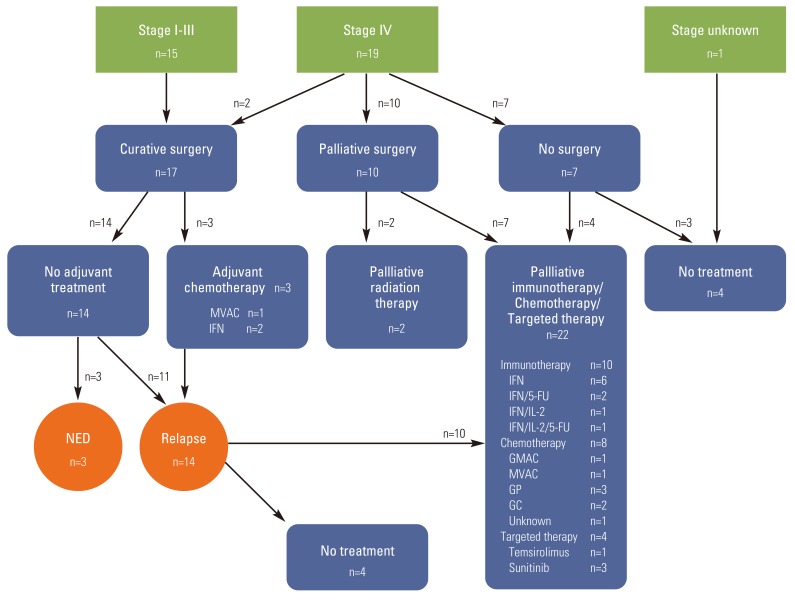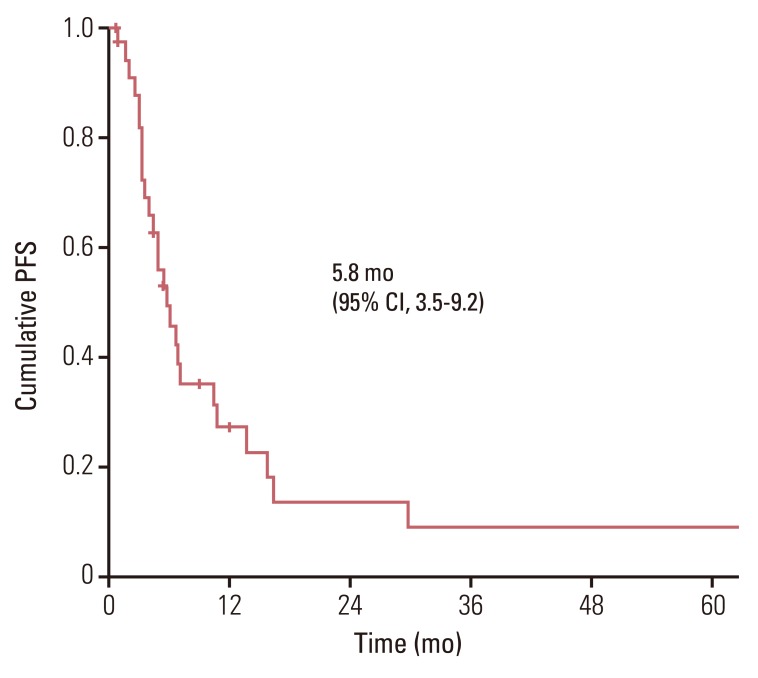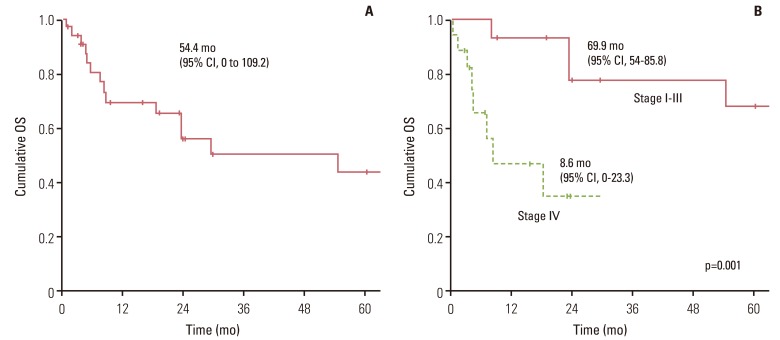Cancer Res Treat.
2014 Apr;46(2):141-147.
Clinical Features and Treatment of Collecting Duct Carcinoma of the Kidney from the Korean Cancer Study Group Genitourinary and Gynecology Cancer Committee
- Affiliations
-
- 1Division of Hematology-Oncology, Department of Internal Medicine, Dongnam Institute of Radiological and Medical Sciences, Busan, Korea.
- 2Department of Internal Medicine, Dong-A University College of Medicine, Busan, Korea.
- 3Department of Internal Medicine, Hallym University Medical Center, Hallym University College of Medicine, Seoul, Korea.
- 4Department of Internal Medicine, Yonsei University College of Medicine, Seoul, Korea. rha7655@yuhs.ac
- 5Department of Internal Medicine, Seoul National University College of Medicine, Seoul, Korea.
- 6Department of Medicine, Samsung Medical Center, Sungkyunkwan University School of Medicine, Seoul, Korea.
- 7Division of Hematology/Oncology, Department of Internal Medicine, Chonbuk National University Medical School, Jeonju, Korea.
- 8Department of Internal Medicine, Chungnam National University College of Medicine, Daejeon, Korea.
- 9Division of Medical Oncology, Department of Internal Medicine, The Catholic University College of Medicine, Seoul, Korea.
Abstract
- PURPOSE
Collecting duct carcinoma (CDC) of the kidney is an aggressive disease with a poor prognosis, accountings for less than 1% of all renal cancers. To date, no standard therapy for CDC has been established. The aim of this study is an investigation of clinicopathologic findings of CDC and correlation of the disease status with a prognosis.
MATERIALS AND METHODS
From 1996 to 2009, 35 patients with CDC were treated at eight medical centers. The diagnosis of CDC was made based on nephrectomy in 27 cases and renal biopsy in eight cases.
RESULTS
Median PFS and OS for all patients were 5.8 months (95% CI 3.5 to 9.2) and 54.4 months (95% CI 0 to 109.2), respectively. The OS of patients with Stages I-III was 69.9 months (95% CI 54.0 to 85.8), while that of patients with Stage IV was 8.6 months (95% CI 0 to 23.3), which showed a statistically significant difference (p=0.01). In addition, among patients with Stage IV, the OS of patients who received a palliative treatment (immunotherapy, chemotherapy, or targeted therapy) was 18.4 months, which was higher than the OS of patients without treatment of 4.5 months.
CONCLUSION
CDC is a highly aggressive form of renal cell carcinoma. Despite most of the treatments, PFS and OS were short, however, there were some long-term survivors, therefore, conduct of additional research on the predictive markers of the several clinical, pathological differences and their treatments will be necessary.
Keyword
MeSH Terms
Figure
Reference
-
1. Cohen HT, McGovern FJ. Renal-cell carcinoma. N Engl J Med. 2005; 353:2477–2490. PMID: 16339096.
Article2. Verdorfer I, Culig Z, Hobisch A, Bartsch G, Hittmair A, Duba HC, et al. Characterisation of a collecting duct carcinoma by cytogenetic analysis and comparative genomic hybridisation. Int J Oncol. 1998; 13:461–464. PMID: 9683779.
Article3. Auguet T, Molina JC, Lorenzo A, Vila J, Sirvent JJ, Richart C. Synchronus renal cell carcinoma and Bellini duct carcinoma: a case report on a rare coincidence. World J Urol. 2000; 18:449–451. PMID: 11204268.
Article4. Srigley JR, Eble JN. Collecting duct carcinoma of kidney. Semin Diagn Pathol. 1998; 15:54–67. PMID: 9503506.5. Miyamoto H, Kuwamitsu O, Moriyama M, Sakanishi S, Fujii H, Fukushima S, et al. Bellini duct carcinoma of the kidney. Urol Int. 1992; 48:460–462. PMID: 1413315.
Article6. Kobayashi N, Matsuzaki O, Shirai S, Aoki I, Yao M, Nagashima Y. Collecting duct carcinoma of the kidney: an immunohistochemical evaluation of the use of antibodies for differential diagnosis. Hum Pathol. 2008; 39:1350–1359. PMID: 18602672.
Article7. Orsola A, Trias I, Raventos CX, Espanol I, Cecchini L, Orsola I. Renal collecting (Bellini) duct carcinoma displays similar characteristics to upper tract urothelial cell carcinoma. Urology. 2005; 65:49–54. PMID: 15667862.
Article8. Dimopoulos MA, Logothetis CJ, Markowitz A, Sella A, Amato R, Ro J. Collecting duct carcinoma of the kidney. Br J Urol. 1993; 71:388–391. PMID: 8499979.
Article9. Oudard S, Banu E, Vieillefond A, Fournier L, Priou F, Medioni J, et al. Prospective multicenter phase II study of gemcitabine plus platinum salt for metastatic collecting duct carcinoma: results of a GETUG (Groupe d'Etudes des Tumeurs Uro-Genitales) study. J Urol. 2007; 177:1698–1702. PMID: 17437788.10. Therasse P, Arbuck SG, Eisenhauer EA, Wanders J, Kaplan RS, Rubinstein L, et al. New guidelines to evaluate the response to treatment in solid tumors. European Organization for Research and Treatment of Cancer, National Cancer Institute of the United States, National Cancer Institute of Canada. J Natl Cancer Inst. 2000; 92:205–216. PMID: 10655437.11. Mancilla-Jimenez R, Stanley RJ, Blath RA. Papillary renal cell carcinoma: a clinical, radiologic, and pathologic study of 34 cases. Cancer. 1976; 38:2469–2480. PMID: 1000477.12. Kim JH, Choi WG, Yoon JY, Hwang TK, Park YH, Kim BK. A case of collecting duct carcinoma of the kidney. Korean J Urol. 1992; 33:888–891.13. Woo JW, You SJ, Lee CK, Rhew HY. A case of collecting duct carcinoma of kidney. Korean J Urol. 1997; 38:551–554.14. Lee JE, Won HS, Kang JH, Hong YS, Oh SN, Kim TJ, et al. Metastatic collecting duct (Bellini duct) carcinoma: a case report. Korean J Med. 2009; 77:780–786.15. Tokuda N, Naito S, Matsuzaki O, Nagashima Y, Ozono S, Igarashi T, et al. Collecting duct (Bellini duct) renal cell carcinoma: a nationwide survey in Japan. J Urol. 2006; 176:40–43. PMID: 16753362.
Article16. Chao D, Zisman A, Pantuck AJ, Gitlitz BJ, Freedland SJ, Said JW, et al. Collecting duct renal cell carcinoma: clinical study of a rare tumor. J Urol. 2002; 167:71–74. PMID: 11743278.
Article17. Peyromaure M, Thiounn N, Scotte F, Vieillefond A, Debre B, Oudard S. Collecting duct carcinoma of the kidney: a clinicopathological study of 9 cases. J Urol. 2003; 170(4 Pt 1):1138–1140. PMID: 14501710.
Article18. Mejean A, Roupret M, Larousserie F, Hopirtean V, Thiounn N, Dufour B. Is there a place for radical nephrectomy in the presence of metastatic collecting duct (Bellini) carcinoma? J Urol. 2003; 169:1287–1290. PMID: 12629344.
- Full Text Links
- Actions
-
Cited
- CITED
-
- Close
- Share
- Similar articles
-
- A Case of Collecting Duct Carcinoma of Kidney
- A case of collecting duct carcinoma of the kidney
- Fine Needle Aspiration Cytology of Collecting Duct Carcinoma of the Kidney: A Case Report
- Collecting Duct Carcinoma of the Kidney Mimicking Invasive Transitional Cell Carcinoma: A Case Report
- Urothelial Carcinoma of the Renal Pelvis with Synchronous Ipsilateral Collecting Duct Carcinoma: Two Case Reports




